Giraffes are known for their long necks, unique spots, and gentle nature. However, there has been a debate on whether these majestic creatures are strictly herbivorous or have the ability to process meat.
The question is, do giraffes eat meat? While giraffes are primarily herbivores and rely on vegetation for sustenance, there have been rare instances where they have been observed consuming animal products.
The process of meat digestion in giraffes is different from that of carnivores or omnivores due to their unique digestive system.
Giraffes have a four-chambered stomach that allows them to break down tough plant material efficiently. This digestive system also enables them to extract more nutrients from vegetation than other herbivores. However, the process is not as efficient.
While some researchers argue that giraffes may occasionally consume animal products such as insects or small animals like birds and rodents, it is not a significant part of their diet. In fact, most observations of giraffe behavior show them browsing on leaves and twigs high up in trees.
The debate on whether giraffes are strictly herbivorous or have the ability to process meat is ongoing and requires further research and observation. It’s important to note that while there may be rare instances where giraffes consume animal products, it’s not something they rely on for sustenance.
Giraffe Diet Overview
Giraffes are majestic creatures and one of the most recognizable animals in the world. They are known for their long necks, which help them reach leaves that other herbivores cannot. But what do giraffes eat? In this section, we will explore the diet of giraffes and how they survive on a mostly plant-based diet.
Herbivorous Diet
Giraffes are herbivores, meaning they only eat plants. Their diet consists mainly of leaves, flowers, and fruits. They have a preference for acacia trees because their leaves are high in protein and nutrients. However, they also consume leaves from other trees such as baobab, cape chestnut, and sausage tree.
Digestive System
Giraffes have a unique digestive system that allows them to extract as much nutrition as possible from their food. They have a four-chambered stomach that breaks down vegetation with the help of microorganisms.
The first chamber is called the rumen where bacteria break down tough cellulose fibers into simpler compounds like fatty acids and amino acids.
The second chamber is called the reticulum where food particles are separated by size before being regurgitated back up to be chewed again (also known as cud).
After chewing for some time, the food is swallowed again and passes through the third chamber called omasum where water is extracted before moving onto the fourth chamber called abomasum which functions similarly to our stomachs.
Food Consumption
Giraffes can consume up to 75 pounds of vegetation per day depending on availability in their habitat. They spend most of their day eating since it takes a lot of energy to digest all that plant matter.
Giraffes use their long tongues (up to 18 inches) to grasp branches and strip off leaves without getting poked by thorns or prickles.
Occasional Meat Consumption
Despite being herbivores, giraffes have been observed occasionally chewing on bones or licking carcasses. However, this behavior is rare and not considered a part of their regular diet. In fact, it is believed that they do this to obtain minerals like calcium and phosphorus which are scarce in their diet.
Giraffe Diet Adaptation
Giraffes have adapted to their environment by developing a specialized diet and digestive system. They have evolved to be able to consume large amounts of vegetation in a short time while minimizing the risk of predation. Their long necks allow them to reach leaves that other animals cannot, giving them an advantage over competitors for food resources.
What Do Giraffes Eat? Herbivore Diet, Meat Consumption, and Baby Giraffe Diet
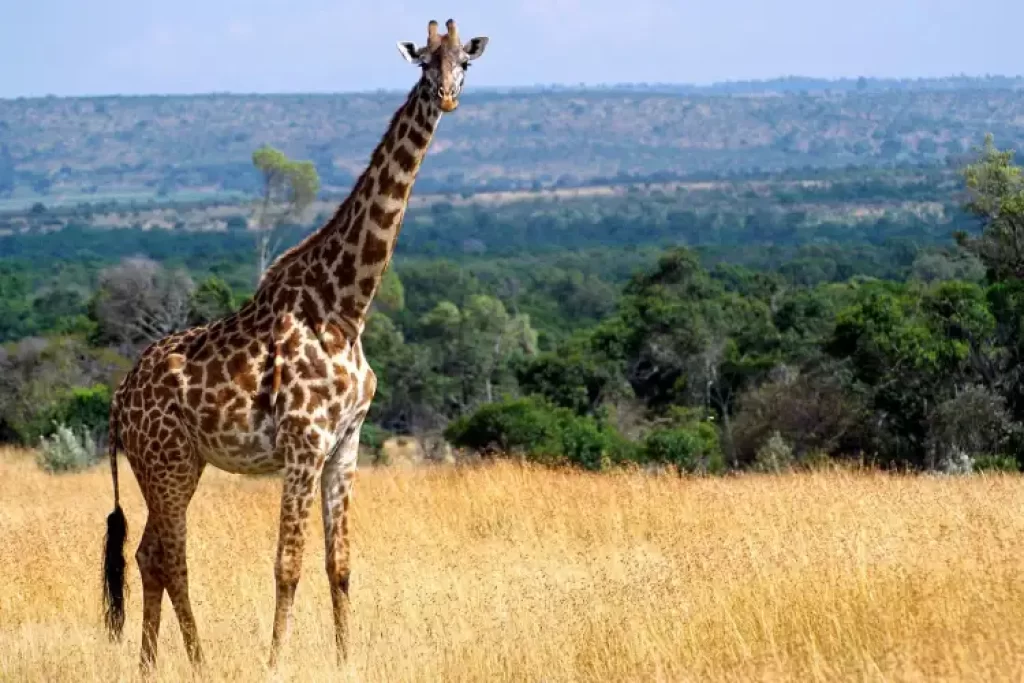
Herbivore Diet: Giraffes Only Eat Plant-Based Foods
Giraffes are known for their long necks, which allow them to reach high branches and leaves that other animals cannot access.
This unique physical characteristic is a result of their highly specialized herbivore diet. Giraffes are strictly herbivores, which means they only eat plant-based foods such as leaves, flowers, fruits, and bark.
Their herbivore diet is essential for their survival in the wild. They have a four-chambered stomach that allows them to digest tough plant material efficiently. Their digestive system enables them to extract the maximum amount of nutrients from the food they consume.
Herbivores have evolved over time to live on a vegetarian diet by developing specific adaptations in their anatomy and physiology. In the case of giraffes, their long necks and tongues enable them to reach high branches and leaves that other animals cannot access.
Baby Giraffe Diet: What Do Baby Giraffes Eat?
Like adults, baby giraffes also follow an herbivore diet consisting of leaves, flowers, fruits, and bark. However, baby giraffes require more protein than adult giraffes because they need it for growth and development.
Baby giraffes rely on their mother’s milk for the first six months of life before transitioning to solid food. During this period, they consume up to 10 liters of milk per day! After six months old, baby giraffes start eating solid foods but continue nursing until they are about one year old.
Meat Consumption: Rare Instances
Although giraffes are strictly herbivores with no intention of consuming meat or animal products whatsoever in general circumstances; there have been rare instances where they have been observed eating meat or bones. Although this behavior is not typical among these animals and may be due to nutrient deficiency in their diet.
In some cases where there has been a lack of vegetation, giraffes have been observed eating bones. This behavior is believed to be a way for them to obtain minerals and nutrients that are not present in their regular diet.
Another rare instance where giraffes have been observed consuming meat is during fights between males. These fights can be violent, and the losing male may resort to eating the winner’s feces or even its carcass as a sign of defeat.
Surprising Foods in a Giraffe’s Diet: Winter Plants and Bones
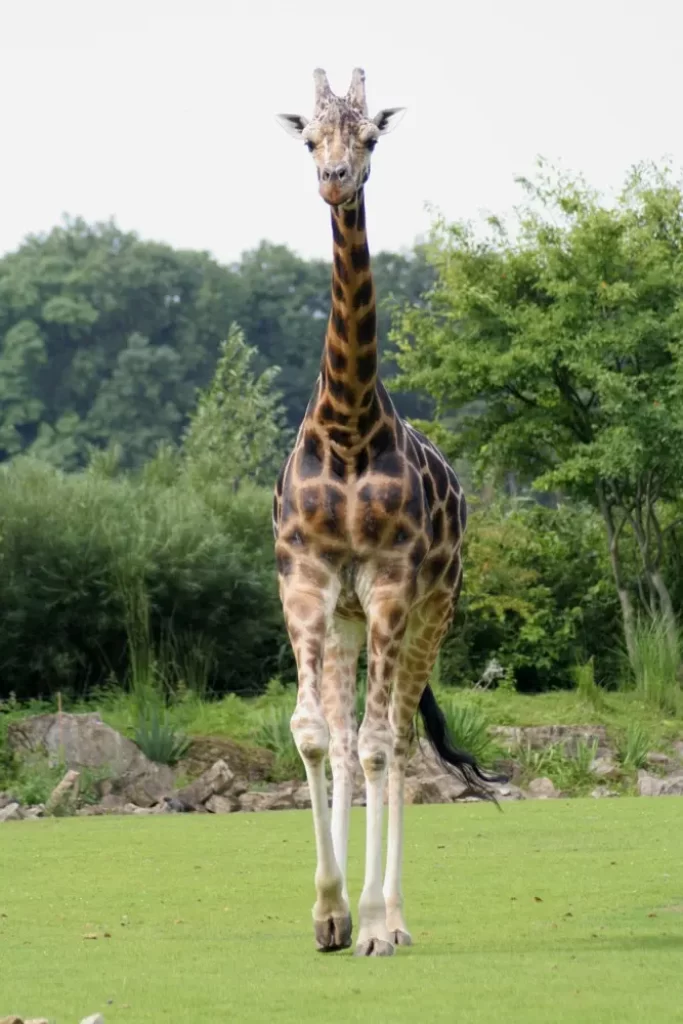
Giraffes are fascinating creatures that have captured the attention of many people around the world. They are known for their long necks, but did you know that they also have a unique diet? Giraffes are herbivores, which means that they only eat plants. However, during winter when plants are scarce, giraffes resort to eating the bark and branches of trees to survive.
Eat Plants
Giraffes primarily eat leaves from trees such as acacia, mimosa, and wild apricot. These trees provide giraffes with the necessary nutrients and water they need to survive in their natural habitat. In addition to leaves, giraffes also eat fruits such as the pods of the Acacia tree and flowers of the Combretum tree.
Fruits
The pods of the Acacia tree contain high levels of protein and minerals that are essential for giraffe’s growth and development. The Combretum tree produces beautiful flowers that attract insects which serve as an additional source of protein for giraffes.
Eat Leaves
It is interesting to note that giraffes have a unique way of eating leaves from tall trees. They use their long necks to reach high up into the trees where other animals cannot reach. Their tongues can extend up to 18 inches long enabling them to wrap around branches and pull off leaves with ease.
Trees
However, during winter months when food is scarce in their natural habitat, giraffes must resort to eating bark and branches from trees. This practice is called “bark stripping” or “branch browsing.” Bark stripping involves removing strips of bark from trees while branch browsing involves breaking off smaller branches from trees.
Bones
Surprisingly, giraffes also eat bones! Giraffes chew on bones from carcasses or even their own shed bones. Bones provide giraffes with calcium and phosphorus which are essential minerals for bone growth and maintenance.
Winter Plants
During winter months, giraffes must rely on a variety of plants to survive. They eat the leaves and bark of trees such as acacia, mimosa, and wild apricot. Giraffes also eat fruits such as the pods of the Acacia tree and flowers of the Combretum tree. However, when food is scarce, they resort to eating bark and branches from trees.
Calcium and Phosphorus Intake
Giraffes need calcium and phosphorus for bone growth and maintenance. Bones provide these essential minerals which are necessary for their survival. Giraffes chew on bones from carcasses or even their own shed bones to supplement their calcium and phosphorus intake.
Studies have shown that giraffes have a unique digestive system that allows them to extract nutrients from tough plant materials such as leaves and bark. Their stomachs contain four compartments which help break down food before it enters the small intestine where nutrients are absorbed into their bodies.
The Giraffe with a Taste for Meat: Caught Munching on a Bone in South Africa
Giraffes are known for their long necks and their ability to reach high up into trees to feed on leaves. They are also known for being herbivores, meaning they only eat plants. However, a recent video captured in South Africa has surprised many people as it shows a giraffe munching on a bone. This behavior is not typical of giraffes, but it is not entirely unheard of either.
Unique Adaptation: Prehensile Tongues
The giraffe caught on camera was using its prehensile tongue to strip the meat off the bone. Giraffes have long tongues that can extend up to 18 inches, which allows them to grasp and manipulate food with ease. This unique adaptation helps them feed on hard-to-reach leaves and branches in trees.
Herbivore or Omnivore?
While giraffes are primarily herbivores, they have been observed eating small amounts of meat in the wild. For example, they may accidentally consume insects or small animals while feeding on plants. In zoos, giraffes are typically fed a diet of hay, fruits, and vegetables. However, some facilities may provide them with bones or other sources of protein as a supplement.
Survival Strategy
Giraffes’ ability to eat bones and other non-plant materials may be an important survival strategy for them during times of food scarcity or drought. In such situations, they may need to resort to eating whatever they can find in order to survive.
Specialized Digestive System
Giraffes have specialized digestive systems that allow them to extract nutrients from tough plants like acacia and mimosa. They also have strong jaws and teeth that can crush bones and chew tough materials.
Feeding Habits in Zoos
In zoos, giraffes are typically fed hay along with fruits and vegetables as part of their regular diet. However, some facilities may provide them with bones or other sources of protein as a supplement. This is done to ensure that they receive all the necessary nutrients for their health and well-being.
Winter Plants in a Giraffe’s Diet: Nutrient Needs and Consumption
Giraffes are known for their long necks, but they also have a unique diet that is essential to their survival. During the winter season, giraffes rely on a variety of plants to meet their nutritional needs. These plants include grasses, shrubs, and other types of vegetation that provide the necessary nutrients for giraffes to maintain their health and wellbeing.
Nutrition is key for giraffes during the winter season, as they consume more leaves and leaf matter than they do during other times of the year. Leaves provide essential nutrients such as protein and fiber that are necessary for maintaining healthy populations in the wild. Giraffes are able to consume large amounts of plant matter due to their specialized digestive system, which allows them to break down tough fibers and extract nutrients from tough plant material.
In addition to plant matter, giraffes require access to water sources throughout the winter months. Water is essential for maintaining hydration levels and promoting overall health in giraffe populations. Without access to water sources, giraffes may become dehydrated or suffer from other health issues that can impact their survival.
Giraffes consume a wide variety of plants during the winter season, including grasses, shrubs, and other types of vegetation. Grasses are an important source of nutrition for giraffes as they contain high levels of protein and fiber that help promote healthy digestion and overall health in these animals.
Shrubs are another important component of a giraffe’s diet during the winter season. Shrubs provide essential nutrients such as vitamins and minerals that are necessary for maintaining healthy populations in the wild. In addition to providing nutrition, shrubs also offer shelter from harsh weather conditions such as wind and snow.
Other types of vegetation such as trees also play an important role in a giraffe’s diet during the winter season. Trees provide leaves and bark that contain essential nutrients such as protein and fiber that help promote healthy digestion and overall health in these animals. In addition to providing nutrition, trees also offer shelter from harsh weather conditions and predators.
Quantity and Time Spent Eating: How Much Does a Giraffe Eat?

Giraffes are undoubtedly one of the most fascinating animals in the world. They are known for their incredible height, long necks, and unique spots. But what about their eating habits? How much do they eat, and how long do they spend eating? In this section, we will explore these questions and more.
A giraffe can eat up to 75 pounds of food per day, which is equivalent to about 75% of its body weight. This means that an adult male giraffe weighing around 2,600 pounds would need to consume approximately 1950 pounds of food each week to maintain its weight. Despite their large size, giraffes have small stomachs and need to eat frequently throughout the day to meet their nutritional needs.
On average, a giraffe spends around 16-20 hours per day eating, which is more than any other mammal. This may seem like a lot of time spent eating, but it’s necessary for them to consume enough food to sustain themselves. During the dry season when food is scarce, a giraffe may spend even more time eating to ensure it gets enough nutrients.
Giraffes primarily eat leaves from trees and bushes but may also eat fruits and flowers when available. They use their long necks to reach high branches that other animals cannot access. Interestingly, despite being herbivores, giraffes have been observed licking bones from carcasses in the wild. However, this behavior is not common or well understood.
The amount of food a giraffe eats can vary depending on its height and weight. Taller and heavier giraffes require more food to sustain themselves than shorter ones. For example, an adult male Masai giraffe can grow up to 18 feet tall and weigh over 4,000 pounds while a female reticulated giraffe typically grows up to 15 feet tall and weighs around 2,500 pounds. Therefore, the amount of food they need to consume daily can vary significantly.
Giraffes have a unique digestive system that allows them to extract as many nutrients as possible from their food. They have a four-chambered stomach that breaks down the tough plant material they eat. The first chamber stores the food, which is then regurgitated and chewed again before passing through the other chambers for further digestion.
Digestion Comparison: Four Chambers in a Giraffe’s Stomach and Cow Digestion
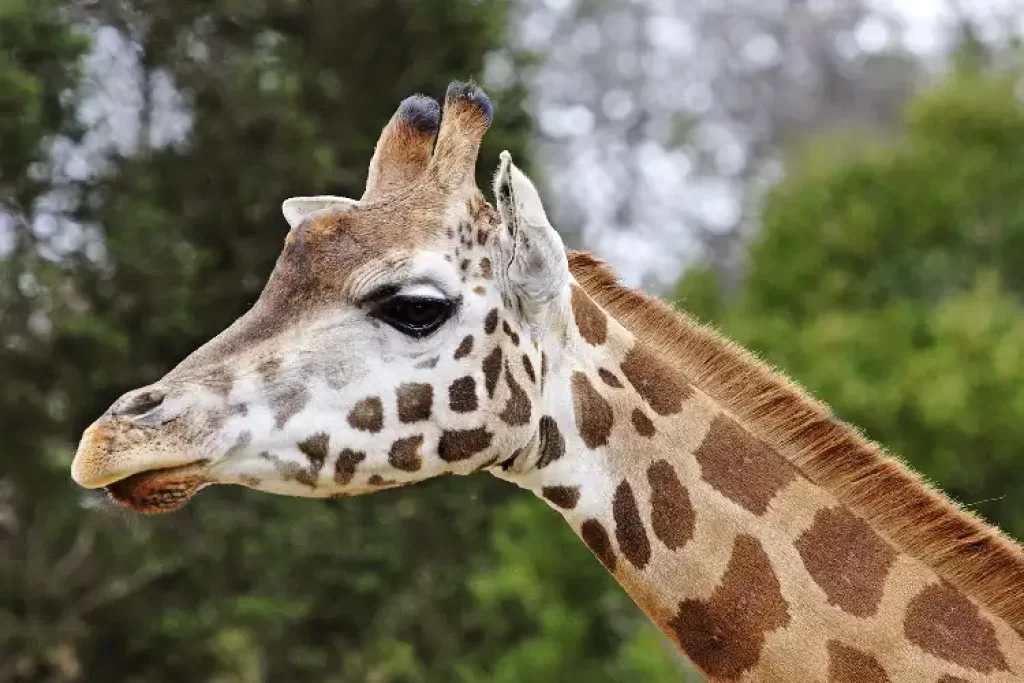
Giraffes have a unique digestive system that sets them apart from other ruminants like cows, sheep, and deer. Unlike these animals, giraffes have four chambers in their stomach that help them break down tough plant material more efficiently.
The first chamber of a giraffe’s stomach is called the rumen, which is similar to the stomach of a cow. The rumen contains bacteria that help break down cellulose, which is the main component of plant cell walls. However, unlike cows, giraffes do not regurgitate their food and chew it again. Instead, they rely on their powerful digestive system to extract as many nutrients as possible from their food.
Giraffes are known for eating leaves from tall trees, which can be tough and fibrous. The four-chambered stomach allows them to digest this material more effectively than other ruminants. The first chamber of the stomach acts as a fermentation vat where bacteria break down cellulose into simpler compounds such as volatile fatty acids (VFAs). These VFAs are then absorbed into the bloodstream and used for energy.
The second chamber of the giraffe’s stomach is called the reticulum. This chamber acts as a filter for larger particles that were not broken down in the rumen. These particles move on to the third chamber of the stomach called the omasum where water is removed before passing onto the fourth and final chamber called abomasum.
The abomasum is similar to a human’s stomach in structure and function. It secretes hydrochloric acid and digestive enzymes to further break down proteins and other nutrients in food.
One interesting fact about giraffes’ digestion is that they can go without drinking water for long periods of time because they get most of their moisture from their food. They also have an efficient urinary system that helps conserve water by producing highly concentrated urine.
In contrast to giraffes’ unique digestive system, ruminants like cows have a three-chambered stomach. The first chamber is the rumen, which is similar to the giraffe’s rumen. However, cows regurgitate their food and chew it again in a process called “cud chewing.” This allows them to break down tough plant material more effectively.
The second chamber of a cow’s stomach is called the reticulum, which acts as a filter for larger particles just like in giraffes. The third and final chamber of the cow’s stomach is called the omasum where water is removed before passing onto the abomasum.
Cows also rely on bacteria in their rumen to break down cellulose into VFAs that are absorbed into the bloodstream for energy. However, unlike giraffes, cows do not have an efficient urinary system and need to drink water regularly.
Do Giraffes Eat Other Animals?
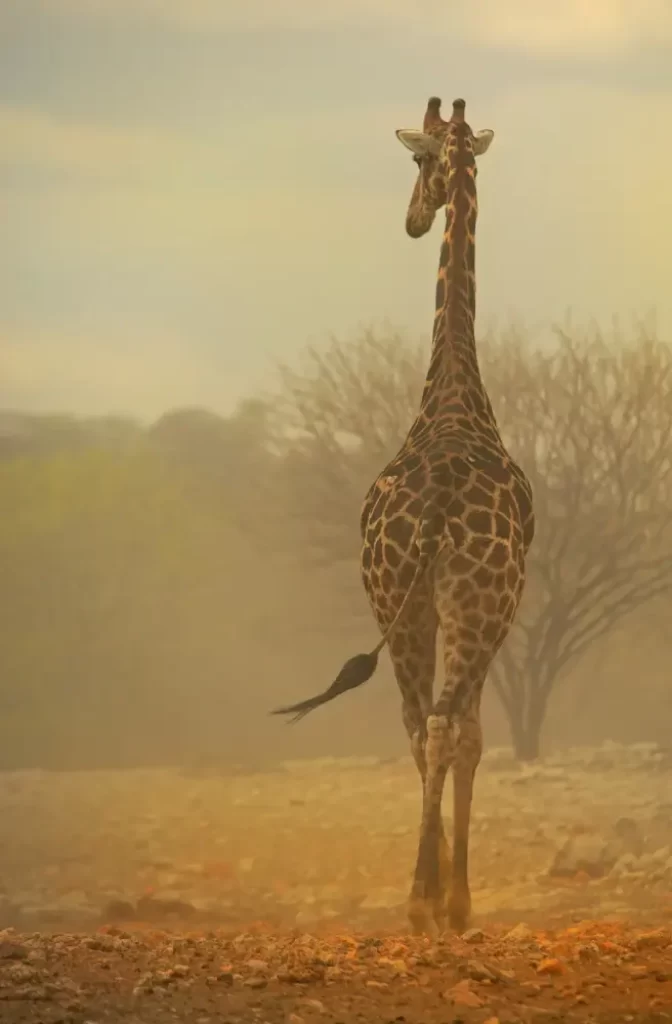
Giraffes are fascinating creatures that have captured the attention of humans for centuries. These majestic animals are known for their long necks, which can reach up to six feet in length and contain only seven vertebrae, just like humans. But what do giraffes eat? Are they carnivores or herbivores? In this section, we will explore the topic of whether giraffes eat other animals.
Giraffes are Herbivores
Giraffes are herbivores, which means that they primarily feed on leaves, flowers, and fruits from trees. They use their long necks to reach high branches that other animals cannot access. Giraffes have a unique digestive system that allows them to extract as many nutrients as possible from their food. They have a four-chambered stomach and regurgitate their food several times before fully digesting it.
No Evidence That Giraffes Eat Other Animals
Despite their impressive size and strength, there is no evidence that giraffes eat other animals. Their long necks and legs are adapted for browsing on tall trees rather than chasing prey. According to AZ Animals, giraffes have been observed licking bones and carcasses of dead animals, but this behavior is believed to be related to the intake of minerals and salts rather than a desire for meat.
Licking Bones and Carcasses
The behavior of giraffes licking bones and carcasses has puzzled scientists for decades. Some researchers believe that this behavior is related to the intake of minerals and salts that are found in bone marrow. Others suggest that it may be a way for giraffes to supplement their diets during times when food is scarce.
Whatever the reason behind this behavior may be, it is important to note that there is no evidence suggesting that giraffes actively hunt or kill other animals for food.
There are numerous social proofs supporting the fact that giraffes are herbivores and do not eat other animals. For instance, the San Diego Zoo states that giraffes are “strictly herbivorous” and feed on “acacia leaves, flowers, and pods.” Similarly, the Smithsonian’s National Zoo & Conservation Biology Institute notes that giraffes are “herbivorous mammals” that feed on “leaves, fruits, and flowers.”
There are also several examples of giraffes exhibiting their herbivorous behavior in the wild. In a study published in the Journal of Zoology, researchers observed giraffes feeding on acacia trees in Tanzania. The giraffes used their long necks to reach high branches and stripped the leaves off with their prehensile tongues.
In another study published in PLOS ONE, researchers analyzed the stomach contents of wild Masai giraffes in Kenya. They found that 97% of the contents were plant material, including leaves from various tree species.
According to AZ Animals, adult giraffes can consume up to 75 pounds of vegetation per day. This includes leaves from acacia trees, which make up a significant portion of their diet.
Recap of Key Points on the Giraffe Diet
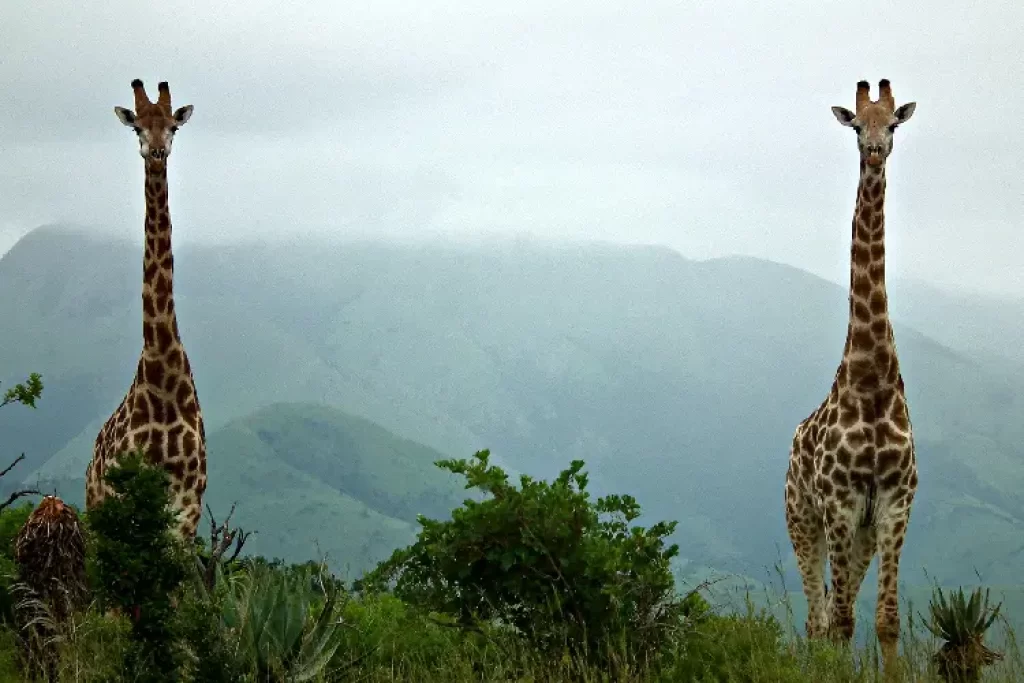
In conclusion, the giraffe is a herbivore that primarily feeds on leaves, flowers, and fruits from trees. However, they have also been known to consume other plants such as wintergreens and bones for their nutrient needs.
Contrary to popular belief, giraffes do not eat meat as a regular part of their diet. The case of the South African giraffe caught munching on a bone was an anomaly and not representative of typical giraffe behavior.
Giraffes are known to spend most of their day eating due to their high nutrient requirements. They have a unique digestive system with four chambers in their stomach that allows them to extract maximum nutrients from their food.
In comparison to cows, who also have four-chambered stomachs, giraffes have longer retention times in each chamber due to their slower digestion process. This enables them to extract more nutrients from their food before excretion.
Overall, the giraffe’s diet is essential for its survival in the wild. Their ability to adapt and consume various types of vegetation ensures they can survive during different seasons and environments.
As we continue learning about these magnificent animals’ dietary habits, it’s important always to remember that they are herbivores at heart and do not regularly consume meat as part of their diet.
References:
- “Giraffe.” Wikipedia, Wikimedia Foundation, 26 Apr. 2023, https://en.wikipedia.org/wiki/Giraffe.
- Strauss, Mark. “Why Do Giraffes Eat Bones?” National Geographic, 23 Oct. 2020, https://www.nationalgeographic.com/animals/article/giraffes-eat-skeletons-bones-spd.
- Mitchell, Jonathan S., et al. “Fossil Evidence and Stages of Elongation of the Giraffa camelopardalis Neck.” Royal Society Open Science, vol. 5, no. 4, Apr. 2018, doi:10.1098/rsos.171773.







